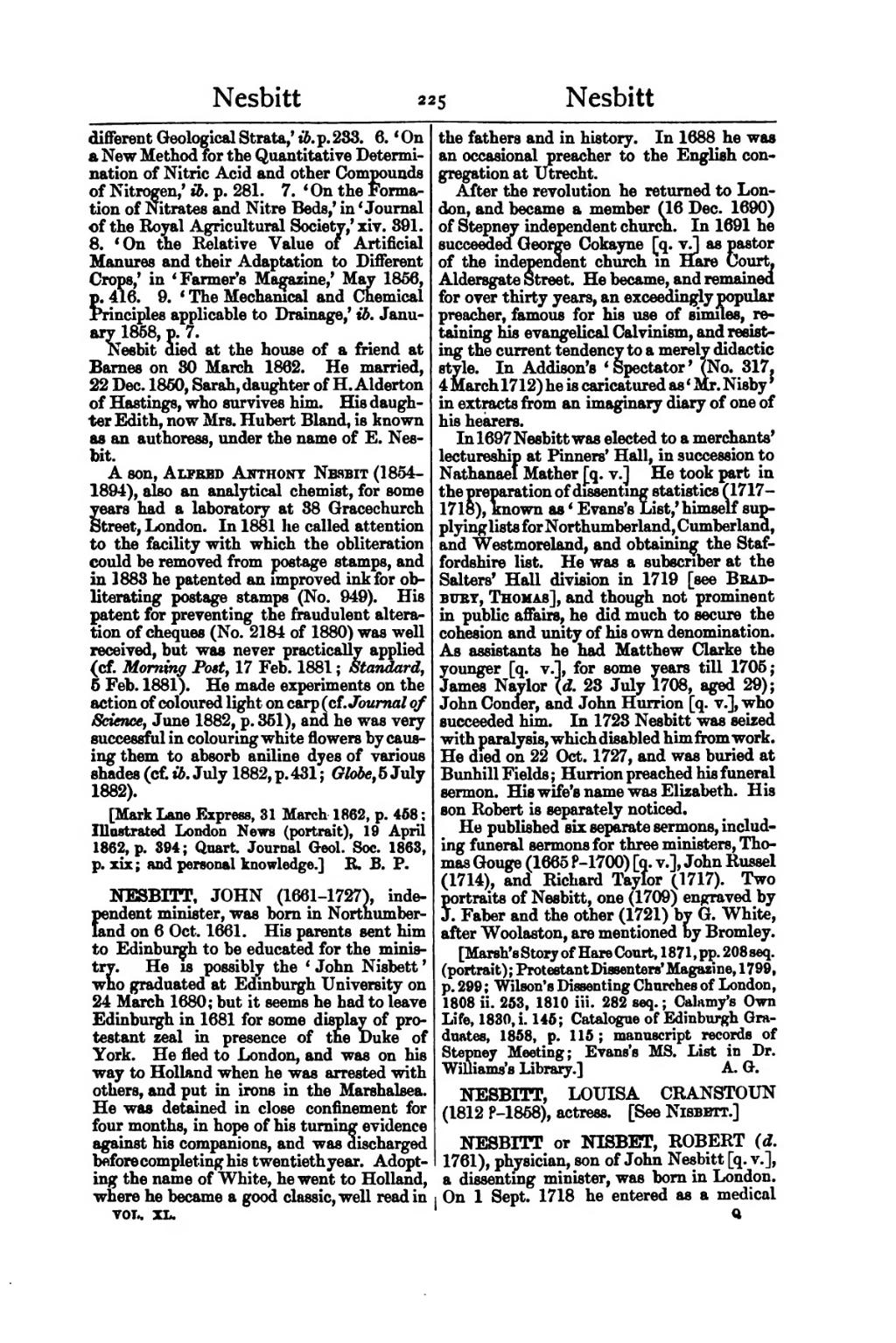different Geological Strata,’ ib. p. 233. 6. ‘On a New Method for the Quantitative Determination of Nitric Acid and other Compounds of Nitrogen,’ ib. p. 281. 7. ‘On the Formation of Nitrates and Nitre Beds,’ in ‘Journal of the Royal Agricultural Society,’ xiv. 391. 8. ‘On the Relative Value of Artificial Manures and their Adaptation to Different Crops,’ in ‘Farmer's Magazine,’ May 1856, p. 416. 9. ‘The Mechanical and Chemical Principles applicable to Drainage,’ ib. January 1858, p. 7.
Nesbit died at the house of a friend at Barnes on 30 March 1862. He married, 22 Dec. 1850, Sarah, daughter of H. Alderton of Hastings, who survived him. His daughter Edith, now Mrs. Hubert Bland, is known as an authoress, under the name of E. Nesbit.
A son, Alfred Anthony Nesbit (1854–1894), also an analytical chemist, for some years had a laboratory at 38 Gracechurch Street, London. In 1881 he called attention to the facility with which the obliteration could be removed from postage stamps, and in 1883 he patented an improved ink for obliterating postage stamps (No. 949). His patent for preventing the fraudulent alteration of cheques (No. 2184 of 1880) was well received, but was never practically applied (cf. Morning Post, 17 Feb. 1881; Standard, 5 Feb. 1881). He made experiments on the action of coloured light on carp (cf. Journal of Science, June 1882, p. 351), and he was very successful in colouring white flowers by causing them to absorb aniline dyes of various shades (cf. ib. July 1882, p. 431; Globe, 5 July 1882).
[Mark Lane Express, 31 March 1862, p. 458; Illustrated London News (portrait), 19 April 1862, p. 394; Quart. Journal Geol. Soc. 1863, p. xix; and personal knowledge.]
NESBITT, JOHN (1661–1727), independent minister, was born in Northumberland on 6 Oct. 1661. His parents sent him to Edinburgh to be educated for the ministry. He is possibly the ‘John Nisbett’ who graduated at Edinburgh University on 24 March 1680; but it seems he had to leave Edinburgh in 1681 for some display of protestant zeal in presence of the Duke of York. He fled to London, and was on his way to Holland when he was arrested with others, and put in irons in the Marshalsea. He was detained in close confinement for four months, in hope of his turning evidence against his companions, and was discharged before completing his twentieth year. Adopting the name of White, he went to Holland, where he became a good classic, well read in the fathers and in history. In 1688 he was an occasional preacher to the English congregation at Utrecht.
After the revolution he returned to London, and became a member (16 Dec. 1690) of Stepney independent church. In 1691 he succeeded George Cokayne [q. v.] as pastor of the independent church in Hare Court, Aldersgate Street. He became, and remained for over thirty years, an exceedingly popular preacher, famous for his use of similes, retaining his evangelical Calvinism, and resisting the current tendency to a merely didactic style. In Addison's ‘Spectator’ (No. 317, 4 March 1712) he is caricatured as ‘Mr. Nisby’ in extracts from an imaginary diary of one of his hearers.
In 1697 Nesbitt was elected to a merchants' lectureship at Pinners' Hall, in succession to Nathanael Mather [q. v.] He took part in the preparation of dissenting statistics (1717–1718), known as ‘Evans's List,’ himself supplying lists for Northumberland, Cumberland, and Westmoreland, and obtaining the Staffordshire list. He was a subscriber at the Salters' Hall division in 1719 [see Bradbury, Thomas], and though not prominent in public affairs, he did much to secure the cohesion and unity of his own denomination. As assistants he had Matthew Clarke the younger [q. v.], for some years till 1705; James Naylor (d. 23 July 1708, aged 29); John Conder, and John Hurrion [q. v.], who succeeded him. In 1723 Nesbitt was seized with paralysis, which disabled him from work. He died on 22 Oct. 1727, and was buried at Bunhill Fields; Hurrion preached his funeral sermon. His wife's name was Elizabeth. His son Robert [q. v.] is separately noticed.
He published six separate sermons, including funeral sermons for three ministers, Thomas Gouge (1665?–1700) [q. v.], John Russel (1714), and Richard Taylor (1717). Two portraits of Nesbitt, one (1709) engraved by J. Faber and the other (1721) by G. White, after Woolaston, are mentioned by Bromley.
[Marsh's Story of Hare Court, 1871, pp. 208 seq. (portrait); Protestant Dissenters' Magazine, 1799, p. 299; Wilson's Dissenting Churches of London, 1808 ii. 253, 1810 iii. 282 seq.; Calamy's Own Life, 1830, i. 145; Catalogue of Edinburgh Graduates, 1858, p. 115; manuscript records of Stepney Meeting; Evans's MS. List in Dr. Williams's Library.]
NESBITT, LOUISA CRANSTOUN (1812?–1858), actress. [See Nisbett.]
NESBITT or NISBET, ROBERT (d. 1761), physician, son of John Nesbitt [q. v.], a dissenting minister, was born in London. On 1 Sept. 1718 he entered as a medical
